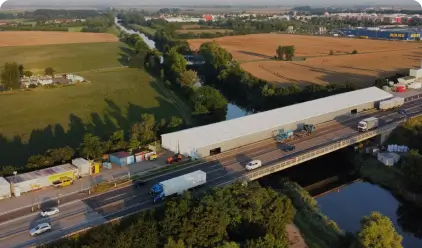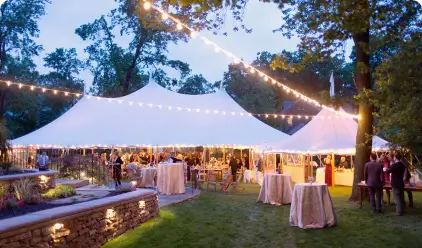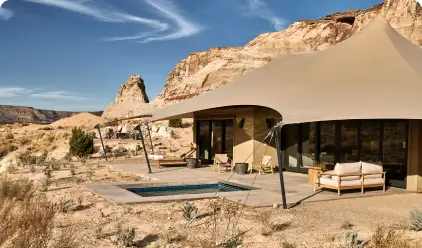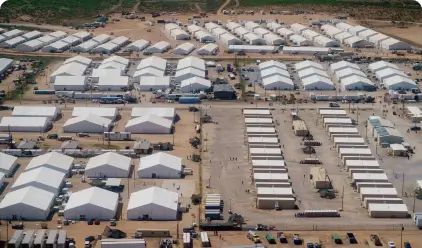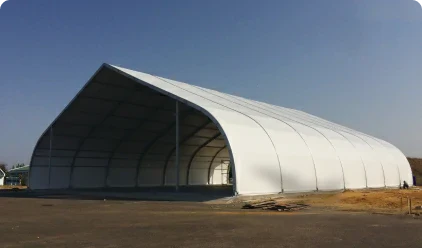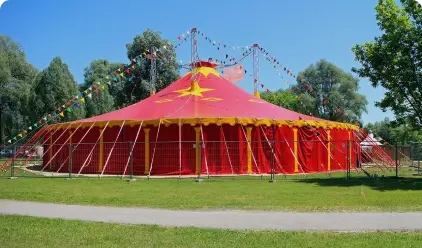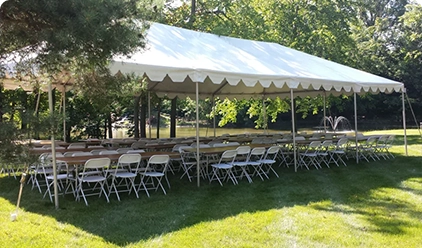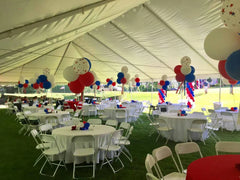How To Start Glamping Business in 2025
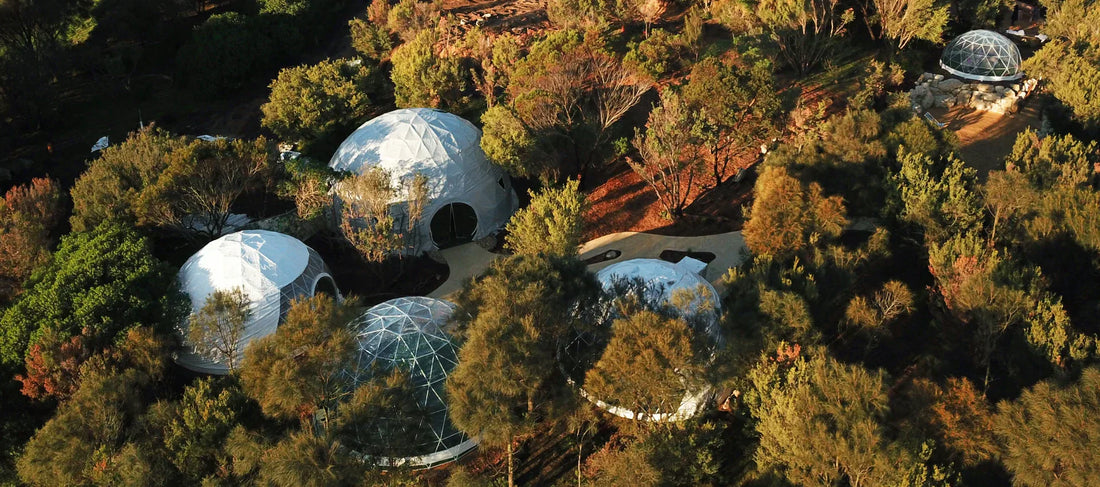
Dreaming of blending nature with luxury to create a unique travel experience? Starting a glamping business in 2025 offers a lucrative opportunity as travelers increasingly seek outdoor escapes without giving up modern comforts. Glamping accommodation, known for its eco-friendly attributes like using organic materials and sustainable practices, also presents significant business potential. From cozy yurts to upscale tiny homes, glamping caters to a wide range of guests, making it a versatile and profitable venture.
In this article, you’ll learn the key steps to launch your glamping business, including exploring zoning laws, selecting the perfect site, and understanding startup costs. We’ll explore different glamping structures, their pricing potential, and how to create unforgettable guest experiences. Whether you’re aiming for a small off-grid retreat or a larger resort-style operation, this guide will help you turn your vision into a thriving business.
Why Start a Glamping Business?
The glamping industry shows a steady rise in demand, making it a profitable venture for 2025.
Outdoor travel preferences are growing as tourists seek immersive yet comfortable stays. Glamping bridges this gap, offering convenience and connection with nature. A glamping business makes money by charging guests for accommodations, detailing pricing structures based on tent size and duration of stay.
You can attract a variety of guests, including:
- Families looking for safe outdoor options.
- Couples wanting a romantic getaway.
- Travelers new to camping who prefer modern amenities.
Nightly rates for glamping accommodations typically range between $100–$300, depending on the type and amenities offered.
Key glamping structures, their costs, and benefits are summarized below:
| Structure Type | Startup Cost per Unit | Lifespan | Nightly Rate |
|---|---|---|---|
| Luxury Tents | $1,500–$5,000 | ~5–10 years | $100–$300 |
| Yurts | $8,000–$20,000 | 10+ years | $120–$250 |
| Tiny Homes | $50,000–$150,000 | 15+ years | $150–$300+ |
Zoning flexibility and higher rates make these structures appealing. For example, luxury tents are affordable to set up, while tiny homes offer longer-term durability and comfort.
Market Trends and Growth Potential
The glamping market has grown steadily, with an annual growth rate of 14.1% projected from 2023 to 2028 (source: Grand View Research). This expansion reflects rising consumer interest in outdoor luxury experiences.
Younger travelers, particularly Millennials and Gen Z, prioritize eco-friendly accommodations. Incorporating sustainable practices, like solar energy or compostable toiletries, attracts this demographic.
Corporate retreats and wellness events are driving higher group bookings. Offering event-specific packages can boost occupancy rates during off-peak seasons.
The value of the global glamping market reached $2.35 billion in 2022. Analysts predict it surpassing $4 billion by 2028, highlighting the impressive valuation and projected growth rates of the global glamping market size, opening new opportunities across various regions.
Key trends shaping glamping in 2025:
- Eco-tourism: Guests opt for low-impact stays; practices like water recycling gain appeal.
- Tech integration: Smart locks, WiFi, and app-based check-ins improve convenience.
- Diverse offerings: Options like treehouses or floating cabins cater to niche markets.
Understanding these trends positions your business to capitalize on the expanding glamping sector.
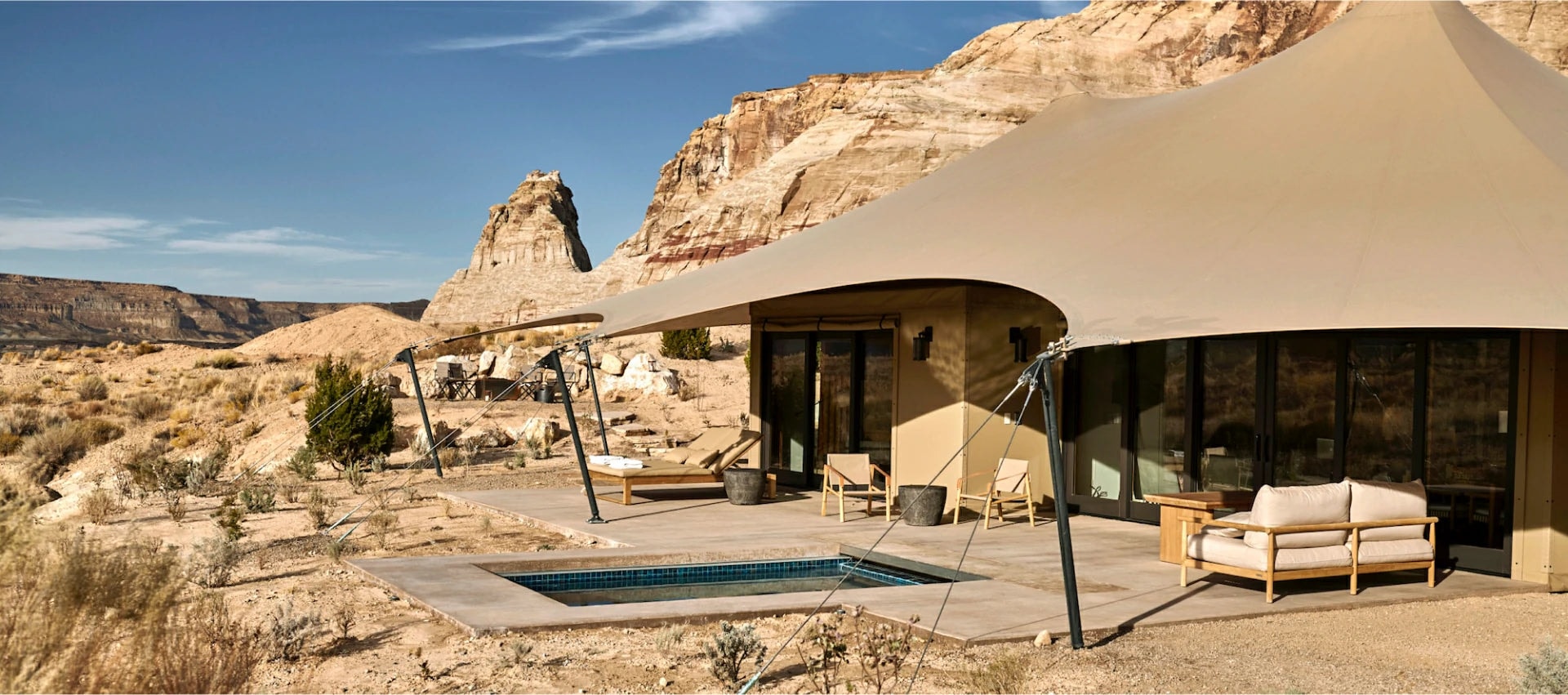
Choosing Your Glamping Business Model
Selecting the right glamping business model shapes your operations, costs, and appeal. Different niches offer varied opportunities and challenges in market demand and revenue generation.
Overview of Different Glamping Niches
Luxury Tents (Safari, Bell Tents)
Canvas structures provide comfortable stays with beds and furniture. Units cost $1,500–$5,000 and require platform bases. Nightly rates range from $100–$300. Frequent upkeep, such as weatherproofing, is needed.
Yurts
Built with wood frames and felt or canvas, these withstand harsh weather. Costs typically range between $5,000–$10,000. Daily rates hover around $150–$400 depending on amenities like wood stoves and insulation.
Treehouses
Elevated wood cabins offer high-impact design but demand significant investment, ranging from $20,000 to $100,000. Popular for families, rates go up to $500/night.
Tiny Homes & Cabins
Compact designs with electricity and plumbing average $30,000–$60,000 per unit. They attract long-stay guests paying $150–$300/night.
Airstreams & Vintage Trailers
Renovated trailers cost $25,000–$60,000 depending on condition and upgrades. Guests enjoy an outdoor feel with indoor modern amenities.
Geodesic Domes & Eco-Pods
Futuristic structures like glamping pods, known for their unique curved wooden design, cost $10,000–$20,000 each. Popular in eco-tourism, rates are between $200–$400 per night.
Safari Lodges & Tented Cabins
Hybrid setups include ensuite bathrooms, costing $20,000–$40,000. These yield high revenue with rates of $200–$400/night.
Off-Grid & Wilderness Retreats
Using solar power and composting toilets, these minimalistic models lower costs while attracting eco-conscious campers.
Comparing Costs, Revenue Potential, and Regulations Across Models
| Model | Startup Cost (per unit) | Revenue Potential (per night) | Key Regulatory Concerns |
|---|---|---|---|
| Luxury Tents | $1,500–$5,000 | $100–$300 | Campground codes |
| Yurts | $5,000–$10,000 | $150–$400 | Weatherproofing requirements |
| Treehouses | $20,000–$100,000 | $250–$500 | Engineering and safety codes |
| Tiny Homes & Cabins | $30,000–$60,000 | $150–$300 | Building permits |
| Airstreams & Vintage Trailers | $25,000–$60,000 | $150–$300 | Vehicle refurbishing laws |
| Geodesic Domes & Eco-Pods | $10,000–$20,000 | $200–$400 | Structural standards |
| Safari Lodges | $20,000–$40,000 | $200–$400 | Fire safety compliance |
| Off-Grid Retreats | $5,000–$15,000 | $100–$200 | Environmental approval |
Choosing the Right Model Based on Budget and Market Demand
Base choices on capital, target guests, and local demand trends. For limited budgets, consider luxury tents or off-grid retreats due to lower costs.
High-budget investors might focus on treehouses, safari lodges, or tiny homes to attract luxury travelers.
Analyze local demographics and seasonality. For instance, yurts and eco-pods suit regions favoring sustainable tourism. Prioritize scalable models for future growth.
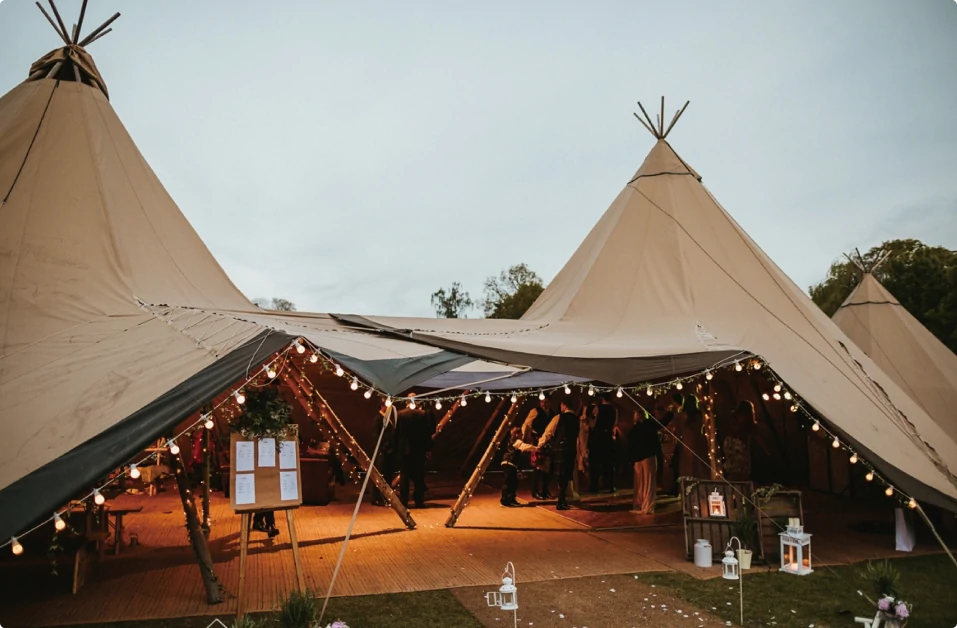
Finding the Perfect Location
Choosing the right location directly impacts your glamping business's appeal and profitability. Consider factors like site features, accessibility, zoning laws, and environmental constraints.
Key Factors for Site Selection
Proximity to Major Cities and Attractions
Sites near urban areas or tourist destinations attract more visitors. For example, locations within a two-hour drive of large cities appeal to weekend travelers. Nearby attractions, such as national parks, hiking trails, or water bodies, boost marketability.
Scenic Appeal & Natural Features
Select sites with unique landscapes, such as mountains, forests, or beachfront. A memorable view enhances the guest experience and justifies premium pricing. Shaded areas and natural privacy are additional advantages.
Accessibility & Infrastructure Needs
Ensure easy access via maintained roads, even in adverse weather conditions. Sites lacking infrastructure require investment in utilities like water, power, and sewage systems, especially for luxury accommodations.
Zoning & Land Use Regulations
Verify zoning laws for your chosen land type. Most glamping sites fall under agricultural, recreational, or commercial zones.
Securing planning permission early in the planning stages is crucial as it can significantly influence site selection, types of units, and compliance with local regulations. This step is essential for obtaining licenses and constructing accommodations legally and successfully.
Check local rules on permits. For example, tiny homes on wheels might need RV park permits, while permanent structures like cabins require residential or commercial construction permits. Confirm rules about short-term lodging to avoid issues.
Environmental and Seasonal Considerations
Account for climate when planning. In winter-dominant regions, create insulated accommodations or offer seasonal services.
Assess risks specific to the area, such as floods or fire hazards. Prioritize locations with trees, streams, or open skies for a serene atmosphere while maintaining sustainable land use with minimal environmental disruption.
Leasing vs. Buying Land for Your Glamping Business
Leasing may reduce initial costs. For example, you could lease agricultural land for several years. But, confirm lease terms allow necessary modifications.
Buying provides long-term control. Purchased land enables strategic upgrades like permanent utility installations or landscaping, but it requires a higher initial investment. Compare land costs in your target market to decide which model works best.
Navigating Legal and Regulatory Requirements
Understanding and complying with regulations is critical for launching your glamping business. Compliance impacts timelines, costs, and operations.
Understanding Local, State, and Federal Regulations
Study regulations at local, state, and federal levels. Local laws often dictate land usage, while state and federal rules may oversee environmental and health requirements.
Check if protected areas restrict development. For example, federal laws might limit activities near wetlands. Consult with planning departments to clarify local permits.
Understanding these layers prevents delays and legal barriers.
Zoning Laws and Special Use Permits
Verify if zoning laws allow campgrounds or lodging on your property. If zoning doesn’t support your plans, apply for a Special Use Permit or Conditional Use Permit (CUP).
Obtain a CUP to address specific community concerns, such as noise or traffic. Public hearings and documentation often accompany this process.
Align your project with zoning criteria to improve approval chances.
Building Codes & Permits (Temporary vs. Permanent Structures)
Separate temporary from permanent structures by understanding building codes. Luxury tents might fall under temporary regulations, while geodesic domes or cabins might need permanent permits.
Clearing codes is essential for regulatory approval. Examples include fire-resistant materials for cabins or windproof design for tents.
Plan structure types and obtain relevant building permits.
Health & Safety Standards (Fire, Sanitation, Waste Management)
Adopt standardized safety measures. Install fire extinguishers, exit signage, and maintain clear pathways for emergencies.
Set up waste disposal systems, such as composting toilets or septic tanks, aligned with local health laws. Pay attention to water testing and sanitation protocols for showers.
Meeting these standards reduces health risks and liability.
Liability and Insurance Requirements
Secure insurance policies that cover potential risks. Liability insurance protects against accidents or property damage claims.
Calculate coverage based on guest capacity and structure types. For instance, treehouses might need higher-risk insurance compared to tents.
Protecting your business with comprehensive coverage enhances guest trust.
Budgeting and Financing Your Glamping Business
Creating a detailed budget is critical for launching your glamping business. Account for upfront investments, ongoing costs, and financing sources to maintain financial stability.
Breakdown of Startup Costs
Land Costs
Land acquisition costs vary by location, size, and proximity to tourist attractions. Leasing land may reduce initial expenses compared to purchasing. Analyze zoning requirements and property restrictions.
Accommodation Costs (Tents, Cabins, Domes, etc.)
Glamping tents, which are crucial to the overall glamping experience, typically range from $1,500 to $40,000 per unit based on size and amenities. High-end cabins or treehouses may exceed $50,000.
Infrastructure (Utilities, Roads, Septic Systems, Solar, etc.)
Allocate funds for roads, utilities, plumbing, and renewable energy solutions. Expect $10,000–$50,000+ for basic infrastructure depending on site size and conditions.
Interior Furnishings & Amenities
Bed frames, mattresses, linens, and climate controls can cost $1,000–$3,000+ per unit. Focus on comfort to attract guests. Add premium items thoughtfully for higher nightly rates.
Permits & Professional Fees
Legal permits, zoning approvals, or architectural services may cost several thousand dollars depending on regulations and project scope.
Marketing & Branding
Set aside $5,000–$10,000 for professional branding, social media campaigns, and website design to attract bookings.
Ongoing Operational Costs
Staffing
Salaries or wages for housekeeping, groundskeepers, and onsite management will range from $30,000–$75,000 per year, depending on scale.
Utilities & Maintenance
Electricity, water, waste disposal, and regular maintenance typically cost $1,000–$2,500 per month for small operations and more for larger resorts.
Booking & Reservation System Fees
Reservation platforms charge 3–10% commission per booking. Budget for subscription fees if using dedicated property management software.
Financing Options
Bank Loans & SBA Loans
Traditional bank loans or Small Business Administration (SBA) loans offer structured repayment terms. Interest rates depend on creditworthiness and repayment period.
Investor Funding & Crowdfunding
Seek private investors or launch crowdfunding campaigns to raise capital. Offer profit-sharing agreements or rewards for contributions.
Grants & Incentives for Rural Hospitality
Investigate grants aimed at rural development or eco-tourism projects. Some programs offer funding or tax benefits for businesses in underserved areas.
Setting Up Your Glamping Site
Careful planning is essential for creating an operational and appealing glamping site. Cover infrastructure, accommodations, shared spaces, and environmental practices to attract guests and meet regulations.
Infrastructure & Utilities Planning
Develop off-grid or grid-tied utility systems depending on the site. Off-grid setups often involve solar panels ($3,000–$10,000 per unit), composting toilets, or wells for water.
Create access roads for vehicles and parking spaces.
Ensure compliance with local zoning laws and environmental regulations, especially on agricultural or rural land.
Accommodation Setup & Design
Select structures like canvas tents, yurts, or treehouses based on budget and theme.
Luxury tents cost $1,500–$5,000, yurts $5,000–$20,000, and treehouses $20,000–$100,000.
Focus on durable materials and weather-resilient designs. For example, use waterproof canvas for tents to handle varied climates.
Common Area & Shared Facilities (Bathrooms, Dining, Fire Pits)
Build shared amenities to increase guest satisfaction.
Add communal fire pits, outdoor seating, and kitchens to foster interaction.
Set up well-equipped bathrooms with water heaters if applicable. A septic system might be needed for permanent accommodations depending on health codes.
Furnishing & Amenities (Beds, Heating, Airflow, Decor)
Provide essentials like quality beds, linens, and temperature-controls. Portable heaters or fireplaces enhance guest comfort in cooler areas.
Incorporate ceiling fans or ventilation options for warm regions.
Opt for simple yet stylish decor, like neutral tones and natural materials, to align with nature-oriented aesthetics.
Sustainable & Eco-Friendly Practices
Use solar power, rainwater collection systems, and energy-efficient appliances.
Avoid harming natural habitats during construction and operations.
Offer compost-friendly waste options and recycled products like furniture or flooring to appeal to eco-conscious travelers.
Running Your Glamping Business
Operating a glamping business involves managing daily operations, guest bookings, maintenance, and seasonal adjustments. Efficient management is key to keeping guests satisfied and maximizing profitability.
Staffing and Day-to-Day Operations
Hire staff based on the size and demands of your site. For a small setup, a few employees can handle cleaning, guest communications, and maintenance. Larger operations may need additional roles, such as cooks or event coordinators.
A glamping host plays a crucial role in refining business practices and enhancing guest experiences. Engaging with guests and utilizing social media to promote offerings are key aspects of a successful glamping host, who combines hospitality with outdoor connection.
Create a daily checklist to manage tasks like restocking supplies, inspecting accommodations, and addressing customer inquiries. Train staff on safety protocols, emergency procedures, and service standards.
Reservation & Booking Management
Use a reservation platform to streamline bookings and track availability. These tools allow real-time updates, online payments, and guest communication.
Offer direct booking options on your website to save on third-party fees. Consider adopting dynamic pricing to adjust rates based on demand, season, or special events.
Guest Check-in/Check-out Procedures
Simplify the process by offering online check-in and keyless entry systems. This minimizes wait times and enhances the guest experience.
Provide clear instructions on checking out, including cleaning expectations or where to leave keys. Ensure staff is available to address late departures or any issues.
Housekeeping & Maintenance Routines
Clean accommodations after every guest stay, focusing on bedding, bathrooms, and outdoor areas. Inspect for wear and tear, such as torn fabrics or malfunctioning fixtures.
Schedule regular maintenance for utility systems like plumbing, heating, and solar panels. Proactively addressing repairs helps avoid guest complaints.
Providing Top-Tier Guest Services
Offer personalized touches like welcome kits or locally-sourced snacks. Respond to guest requests promptly to build a reputation for excellent service.
Provide recommendations for nearby attractions, dining, or outdoor activities. Create an in-app or printed guidebook to enhance convenience and satisfaction.
Handling Seasonality & Off-Peak Strategies
During peak seasons, offer packages like adventure tours or family discounts to draw diverse guests. Streamline operations to handle higher occupancy efficiently.
In off-peak times, attract visitors with discounted rates, themed weekends, or collaborations with event organizers. Create local partnerships for winter activities or wellness retreats to maintain revenue.
Marketing and Attracting Guests
Attracting guests and maintaining visibility is crucial when starting a glamping business in 2025. Effective marketing strategies can increase occupancy rates and build your brand reputation.
Building a Strong Online Presence (Website, SEO, Blogging)
Create a professional website to showcase accommodations, amenities, and booking options. Include high-resolution photos, virtual tours, and clear policies.
A glamping business owner must select the right location, amenities, and differentiating factors to ensure success in a competitive market. Understanding customer expectations and conducting thorough competition analysis are crucial steps.
Use SEO strategies to rank higher in search results. Optimize with keywords like “luxury glamping 2025” and “eco-friendly stays.”
Maintain a blog to share content, such as travel tips, eco-tourism insights, and seasonal attractions. Regular posting builds engagement and improves search rankings.
Leveraging Social Media for Bookings
Post consistently on platforms like Instagram, Facebook, and Pinterest. Share images of your site, guest testimonials, and nearby attractions.
Engage with followers through polls, Q&A sessions, and comment sections. Direct messages can convert inquiries into bookings.
Use paid ads for targeted campaigns. Promote limited-time offers to attract attention and drive reservations.
Listing on Airbnb, Hipcamp, Booking.com & Other Platforms
Register your property on booking sites to reach larger audiences. Platforms like Airbnb, Hipcamp, and Booking.com attract travelers looking for outdoor stays.
Highlight features like eco-friendly designs and luxury amenities to stand out. Use competitive pricing to attract bookings early on.
Monitor reviews and respond professionally to improve your reputation and ranking on these platforms.
Partnering with Influencers and Travel Bloggers
Contact influencers within the travel and eco-tourism niches. Offer complimentary stays in exchange for social coverage.
Collaborate with bloggers to write articles about your glamping experience. Their audiences may align with your target market.
Track campaign results by monitoring clicks, traffic, and bookings generated from influencer posts.
Creating Unique Guest Experiences that Drive Word of Mouth
Offer experiences like guided hikes, stargazing nights, or eco-workshops. Activities add value to the stay and encourage better guest feedback.
Encourage satisfied guests to leave detailed reviews online. Positive word of mouth increases trust for new customers.
Design photo-worthy spots on-site to increase social media shares and tap into user-generated content.
Running Promotions & Special Packages
Introduce discounts for early bookings or mid-week stays during low seasons. Limited-time offers create urgency among potential guests.
Establishing a successful glamping business involves highlighting key factors such as site selection, accommodations, and amenities that cater to customer desires for luxury and unique experiences.
Bundle services with local partners, such as winery tours or adventure activities, to add extra appeal.
Promote holiday-themed packages or events to attract guests during special occasions like New Year’s Eve or Valentine’s Day.
Guest Experience & Hospitality Best Practices
Creating a Comfortable & Immersive Nature Experience
Focus on blending comfort with the natural setting. Offer quality bedding, ergonomic furniture, and weather-resistant materials in accommodations such as safari tents or yurts.
Provide nature-based aesthetics like wooden decks, woven rugs, or natural lighting to connect guests with the environment. Add features like fire pits or outdoor seating areas to enhance the experience.
Personalized Touches & Upsell Opportunities
Include welcome packages with local snacks or handwritten notes to create personalized experiences. Offer custom add-ons like private dinners, spa services, or guided tours to increase revenue.
Upsell premium amenities, such as heated blankets for colder seasons or portable fans for warmer months, to improve comfort. Offer exclusive packages for special celebrations like anniversaries or birthdays.
Activities, Add-ons, and Local Partnerships
Curate activities like hiking, yoga sessions, or stargazing events. Partner with local businesses to offer wine tastings, guided nature walks, or craft workshops that reflect the region's culture.
Add seasonal offerings, such as canoeing in summer or snowshoe trekking in winter, to attract year-round guests. Collaborate with eco-tourism groups to create educational experiences.
Safety, Security, and Emergency Preparedness
Install secure locks, adequate lighting, and monitored systems to prioritize guest safety. Provide fire extinguishers, first-aid kits, and safety instructions in easily accessible locations.
Outline evacuation plans and prepare for natural risks like flooding or storms. Train staff in CPR and emergency responses to handle incidents promptly.
Managing Reviews & Reputation Online
Proactively request reviews from satisfied guests on platforms like Airbnb or Google. Respond to both positive and negative reviews diplomatically to showcase accountability.
Maintain an active presence on social media to engage with potential and returning guests. Highlight testimonials on your website to build trust and increase bookings.
Scaling Your Glamping Business
Expanding your glamping business can boost revenue and attract a wider audience. Focus on strategic areas to grow operations without compromising quality.
When & How to Expand (Adding More Units, Upgrading Facilities)
Increase accommodations by adding units like geodesic domes or container homes, considering demand. For example, if your site has consistent full bookings, scale up by 10-20%.
Upgrade facilities by enhancing bathrooms, adding outdoor dining areas, or installing Wi-Fi in common spaces.
Simplify scaling by analyzing market trends and guest feedback to inform your next steps. Increase occupancy by investing in units catering to family or luxury travelers.
Offering Additional Services (Events, Retreats, Guided Experiences)
Host wellness retreats with yoga classes, hiking tours, or meditation sessions using existing outdoor spaces.
Offer corporate packages including team-building activities and nearby excursions.
Create nighttime experiences, like stargazing events or outdoor movie nights. These additions attract group bookings and high-value guests.
Revenue Diversification Strategies (Merchandise, Food & Beverage)
Sell branded items like reusable water bottles, apparel, or eco-friendly toiletries from a small shop or online store.
Provide food and beverage options, such as locally-sourced picnic baskets or classic campfire meals.
Introduce seasonal experiences, such as winter glamping with hot drinks or summer cookouts. Diversify income streams while enhancing guest satisfaction.
Turning Your Site into a Luxury Destination
Elevate amenities with private hot tubs, premium bedding, or personal outdoor decks.
Offer concierge services like private chefs or curated itineraries for nearby attractions.
Incorporate high-end designs, such as eco-friendly tiny homes with modern architecture, to appeal to affluent travelers.
Case Studies & Real-World Success Stories
Explore practical insights from successful glamping businesses to guide your strategy.
Small-Scale Owner-Operator Case Study
A single-owner glamping site in Montana started with three safari tents. Each tent cost $4,500, and amenities like basic furniture added $2,000 per unit. The operator generated $120–$180 per night, depending on the season, and achieved a 75% occupancy rate in the first year. Leveraging activities like guided hikes increased bookings and guest satisfaction. Low operating costs and direct management made this model profitable early on.
Mid-Sized Glamping Business with Strong Profits
A 12-unit business in North Carolina focused on upscale yurts and tiny homes. Startup costs totaled $280,000, including structures, utilities, and amenities. Nightly rates averaged $170, appealing to urban weekend travelers. On-site amenities like a communal firepit and yoga classes boosted occupancy to 82%. Group bookings, particularly for events, accounted for 25% of total revenue. A staff of three handled operations effectively.
Large-Scale Glamping Resort Model
A glamping resort in California developed 50 high-end units, including domes, treehouses, and Airstreams. Total investment reached $3.5 million due to advanced infrastructure and luxury finishes. Nightly rates ranged from $250 to $500, targeting affluent travelers. Adding a spa, fine dining, and corporate retreat packages expanded annual revenue to $8 million. Automated booking systems and 20 full-time staff helped manage operations for seamless guest experiences.
Lessons Learned from Top Operators
- Focus on local demand: A business in Oregon customized offerings to hikers by including gear rentals.
- Diversify income streams: Adding merchandise in Colorado generated $5,000 monthly.
- Prioritize sustainability: An eco-resort reduced 30% in energy costs with solar panels.
- Emphasize guest feedback: A Florida site boosted reviews by addressing safety concerns after a storm.
Would adding scalable amenities, like a wellness center or event space, elevate your business potential?
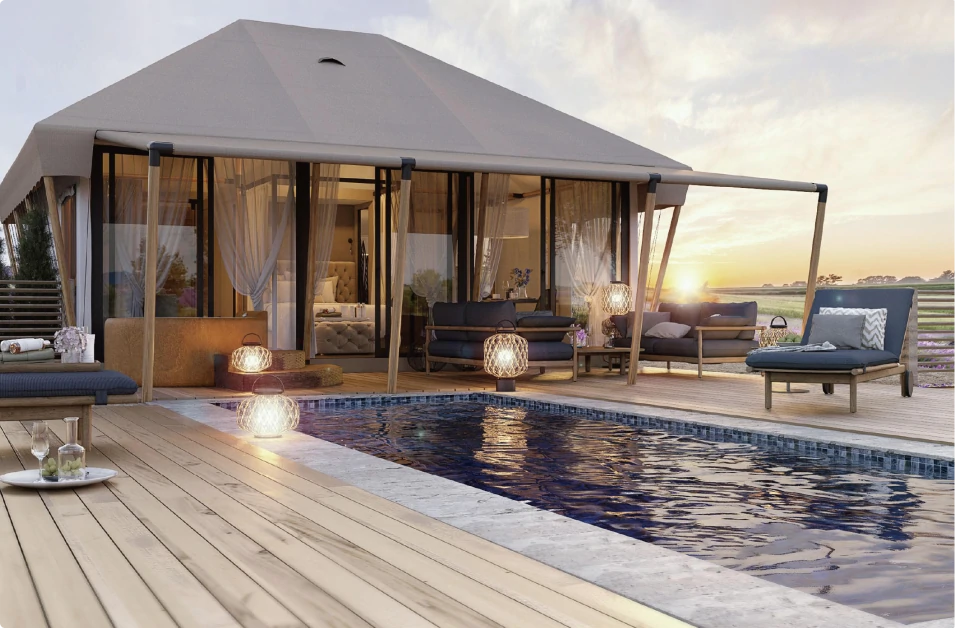
Common Challenges & How to Overcome Them
Dealing with Permitting & Regulatory Hurdles
Compliance with zoning laws and permits can delay your project. Research local land-use regulations and building codes upfront.
Vacation rental owners can explore financing options for their business ventures, particularly in relation to innovative opportunities like glamping. Consider hiring a consultant for legal assistance. Ensure facilities meet health and safety standards required for guests. Check septic system requirements and environmental restrictions before selecting your site.
Secure all necessary permits, such as land-use, construction, and business licenses, to avoid fines or shutdowns.
Managing Weather-Related Risks & Seasonality
Unpredictable weather impacts occupancy rates and infrastructure. Install weather-resilient tents, yurts, or domes to reduce damage during extreme conditions.
Traditional camping involves basic facilities, while glamping incorporates upscale amenities, providing a unique blend of nature and luxury.
Offer discounts during low-demand periods in winter or rainy seasons. Add activities like indoor yoga or guided workshops to attract off-season visitors.
Invest in all-weather heating and cooling systems to maintain comfort during hot summers and cold winters.
Handling Guest Complaints & Negative Reviews
Negative feedback affects your reputation. Train your staff to address complaints promptly and courteously.
Monitor review platforms like Google, Facebook, and TripAdvisor. Respond politely to both positive and negative reviews.
Offer compensation, such as discounts or upgrades, when resolving significant issues like accommodation defects or service delays.
Avoiding Cash Flow Problems & Managing Growth Smartly
Unstable cash flow limits expansion and operational efficiency. Start with a clear budget, including contingency funds for unexpected costs.
Track income and expenses monthly. Avoid overextending on debt when financing additional units or upgrades.
Prioritize scalable investments, such as multi-purpose facilities or modular structures. Create diversified revenue streams, like event hosting or merchandise sales, to reduce financial risk.
So now what?
Key Takeaways from This Guide
- Glamping combines outdoor experiences with modern comforts, appealing to diverse travelers.
- The tourism industry is experiencing growth as more vacationers seek unique and socially distanced experiences, and glamping fits perfectly into this trend.
- Global market growth, projected at 14.1% annually, highlights strong opportunities.
- Selecting a location, understanding zoning laws, and budgeting are vital first steps.
- Sustainable practices and guest-focused offerings enhance success.
- Scaling options, such as adding eco-friendly structures, can expand revenue streams.
Actionable Steps to Get Started
- Identify your niche: Determine if you'll target luxury retreats, eco-tourism, or families.
- Secure financing: Calculate startup costs, including permits, accommodations, and infrastructure.
- Scout locations: Look for sites near natural attractions or cities with high tourism demand.
- Comply with regulations: Check zoning laws and secure permits aligned to your site.
- Set up operations: Carry out booking systems and source durable yet comfortable structures.
- Market effectively: Use ads, social media, and partnerships with local businesses to attract guests.
Additional Resources & Industry Associations
- American Glamping Association: Offers business insights, legal support, and networking opportunities.
- Glamping Hub: A platform to list your site while learning effective hosting tips.
- KOA's Market Trends Reports: Provides data on outdoor tourism trends for well-informed choice-making.
- Glamping Show USA: Hosts events highlighting innovative products, services, and strategies.
- Local Small Business Development Centers (SBDC): Helps with business plans and financing guidance.




























